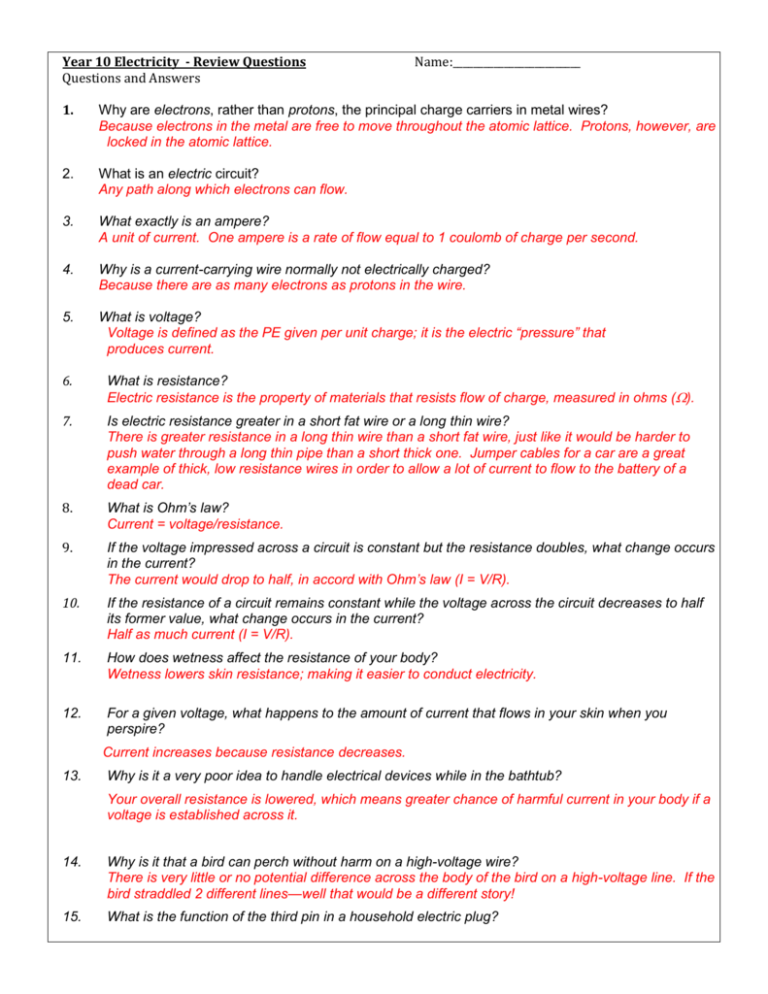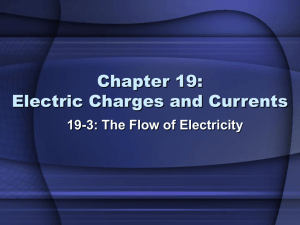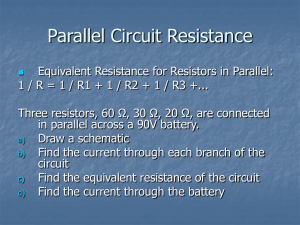Year 10 Electricity Review Questions and Answers
advertisement

Year 10 Electricity - Review Questions Questions and Answers Name:_________________________ 1. Why are electrons, rather than protons, the principal charge carriers in metal wires? Because electrons in the metal are free to move throughout the atomic lattice. Protons, however, are locked in the atomic lattice. 2. What is an electric circuit? Any path along which electrons can flow. 3. What exactly is an ampere? A unit of current. One ampere is a rate of flow equal to 1 coulomb of charge per second. 4. Why is a current-carrying wire normally not electrically charged? Because there are as many electrons as protons in the wire. 5. What is voltage? Voltage is defined as the PE given per unit charge; it is the electric “pressure” that produces current. 6. What is resistance? Electric resistance is the property of materials that resists flow of charge, measured in ohms (). 7. Is electric resistance greater in a short fat wire or a long thin wire? There is greater resistance in a long thin wire than a short fat wire, just like it would be harder to push water through a long thin pipe than a short thick one. Jumper cables for a car are a great example of thick, low resistance wires in order to allow a lot of current to flow to the battery of a dead car. 8. What is Ohm’s law? Current = voltage/resistance. 9. If the voltage impressed across a circuit is constant but the resistance doubles, what change occurs in the current? The current would drop to half, in accord with Ohm’s law (I = V/R). 10. If the resistance of a circuit remains constant while the voltage across the circuit decreases to half its former value, what change occurs in the current? Half as much current (I = V/R). 11. How does wetness affect the resistance of your body? Wetness lowers skin resistance; making it easier to conduct electricity. 12. For a given voltage, what happens to the amount of current that flows in your skin when you perspire? Current increases because resistance decreases. 13. Why is it a very poor idea to handle electrical devices while in the bathtub? Your overall resistance is lowered, which means greater chance of harmful current in your body if a voltage is established across it. 14. Why is it that a bird can perch without harm on a high-voltage wire? There is very little or no potential difference across the body of the bird on a high-voltage line. If the bird straddled 2 different lines—well that would be a different story! 15. What is the function of the third pin in a household electric plug? Serves as a ground for safety reasons. It is called the Earth Pin – it is connected to the Earth via a very low resistance path – to prevent electric shock. 16. 17. Distinguish between dc and ac. Which is produced by a battery and which is usually produced by a generator? Direct current is produced by a battery and flows in only one direction, whereas alternating current is produced by a generator and alternates direction. What does it mean to say that a certain current is 60 Hz? Voltages and currents alternate back and forth at a frequency of 60 cycles per second. 18. What is power? Power = energy/time, rate of doing work or rate at which energy is expended (or used) measured in watts. 19. Which of these is a unit of power and which is a unit of electric energy: a watt, a kilowatt, a kilowatthour? Power is measured in watts or kilowatts; electrical energy is often measured in the kilowatt-hour in the household situation. 20. How many amperes flow through a 60-watt bulb when 120 volts are impressed across it? From P= IV, 60 W = I (120 V); I = 0.5 A. 21. Are all the electrons flowing in a circuit provided by the battery? No, the electrons in a circuit are in both the battery and the circuit itself. 22. Why must there be no gaps in an electric circuit for it to carry current? A gap interrupts flow like closing valve in a water pipe stops the flow. 23. Distinguish between a series circuit and a parallel circuit. Series: single path only; parallel: 2 or more paths. 24. If three lamps are connected in series to a 6-volt battery, how many volts are impressed across each lamp? By symmetry, if 3 identical lamps are connected in series across a 6-volt battery then each lamp has a 2 volt drop across it . 25. If one of three lamps blows out when connected in series, what happens to the current in the other two? If a lamp blows out in a series circuit the current in the other two will stop since there is a break in the circuit—an open circuit has an infinite ( ) resistance. 26. If three lamps are connected in parallel to a 6-volt battery, how many volts are impressed across each lamp? Since each bulb is directly connected to the power source, each lamp will have 6 volts impressed across it—however, the current flowing from the battery will be split across the lamps. 27. If one of three lamps blows out when connected in parallel, what happens to the current in the other two? Current continues unchanged in other two—in parallel there is more than one choice for the current to continue to flow uninterrupted! 28. In which case will there be more current in each of three lamps—if they are connected to the same battery in series or in parallel? If lamps are hooked up in parallel there will be more current than in series since the resistance will be less—3 lamps in parallel will have 3 times less resistance than 1 lamp in series since there are 3x more pathways for the current to flow (think of traffic on a 3-lane highway vs. a 1-lane highway). 29. In which case will there be more voltage across each lamp? In parallel, there will be 6 V across each lamp; whereas in series the voltage is divided equally across the identical lamps at 2 V a piece. 30. What happens to the total circuit resistance when more devices are added to a series circuit? To a parallel circuit? In a series circuits, as more devices are added the resistance increases; whereas in a parallel circuit the overall resistance decreases since there are pathways for the current to flow. 31. What is the equivalent resistance of a pair of 8-ohm resistors in series? In parallel? In series, the equivalent resistance of 2 8-ohm resistance would be 16 ohms since there is twice the resistance to push through, while in parallel the equivalent resistance would only be half as much, 4 ohms since there is twice the pathway. 32. Why does the total circuit resistance decrease when more devices are added to a parallel circuit? The overall circuit resistance decreases as more devices are added in parallel because there ware more pathways for the current to flow. 33. What does it mean when you say that lines in a home are overloaded? Circuits are overloaded when they are carrying more than a safe current; the wires get hot and eventually can start fires! 34. What is the function of a fuse or circuit breaker in a circuit? The function of a fuse or circuit breaker is to halt (stop) dangerously high current by breaking the circuit – melting the fuse if the circuit is too high. 35. Why will too many electrical devices operating at one time often blow a fuse or trip a circuit breaker? When a circuit draws excess current, either the fuse wire will burn out or the bimetallic strip in a circuit breaker will pop open, causing the circuit to break and prevent the flow of charge from causing overheating in the house wires. 36. What is meant by a short circuit? A short circuit occurs when a path of much less resistance is created, allowing excessive amounts of current to flow—like when the positive lead of a power supply is connected to the negative lead; this can be very dangerous! 37. Why are household appliances almost never connected in series? The current would decrease as new appliances connected since the resistance would go up in the circuit; and the voltage across each appliance would decrease as more devices are added in series! Your lamps would get dimmer, hair dryer blow more weakly, toaster toast less, etc.! 38. As more and more lamps are connected in series to a flashlight battery, what happens to the brightness of each lamp? The current diminishes and lamps glow dimmer as lamps are added in series since the overall resistance goes up in the circuit! 39. As more and more lamps are connected in parallel to a battery; and if the current does not produce heating inside the battery; what happens to the brightness of each lamp? The current stays the same of lamps connected in parallel since the voltage stays the same so the brightness of each lamp is not affected! 40. In the circuit shown, how do the brightnesses of the identical bulbs compare? Which light bulb draws the most current? What happens if bulb A is unscrewed? If bulb C is unscrewed? 41. 42. Light bulb C is the brightest while A and B are only 1/4th as bright since they only have ½ the voltage in series and only ½ the current in the branch sine they have twice the resistance in series. Light bulb C draws twice the current of A & B since it has half the resistance; if light bulb A is unscrewed then B will go dark in series while C stays lit; if C is unscrewed than A & B will stay lit in the other branch. A number of light bulbs are to be connected to a battery. Which will provide more overall brightness, connecting them in series or in parallel? Which will run the battery down faster, the bulbs connected in series or the bulbs connected in parallel? Connecting light bulbs in parallel will produce more overall brightness since the voltage will not drop and the overall current drawn from the battery will increase to match the number of devices added. However, the tradeoff is the battery will run down faster with devices hooked up in parallel since more current is drawn (P = IV). A 60-W and a 100-W bulb are connected in series in a circuit. Which bulb has the greater current flowing in it? Which has the greater current when they are connected in parallel? Both lightbulbs will have the same current flowing through them when connected in series because there is only 1 pathway available. In parallel, the 100-W bulb will have more current flowing through it than the 60-W bulb because it has a lower resistance (thicker filament) to allow more current to flow and thus dissipate more









